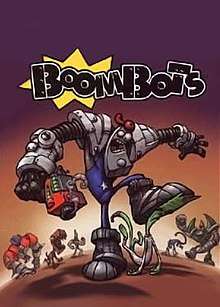BoomBots
BoomBots is a fighting video game released in 1999 for PlayStation. It was created by Doug TenNapel, and it was developed by The Neverhood, Inc. and published by SouthPeak Interactive.[1] BoomBots features distinctive claymation visuals and various amounts of toilet humor. The game was both a critical and commercial failure.
| BoomBots | |
|---|---|
 | |
| Developer(s) | The Neverhood, Inc. |
| Publisher(s) | SouthPeak Interactive |
| Designer(s) | Doug TenNapel |
| Engine | The Neverhood, Inc. |
| Platform(s) | PlayStation |
| Release | |
| Genre(s) | Fighting |
| Mode(s) | Single-player, multiplayer |
Gameplay
BoomBots is a 3D arena fighting game in which the player has the choice of ten characters (boombots) for either single player or multiplayer.[2][3][4][5]
In single player, the objective is to beat recolors of the ten boombots (which includes a recolor of the player's boombot if they aren't a secret boombot) to progress through the story and win the game.[1][5] If the player remains undefeated, they get to fight recolors of secret boombots in secret stages during the story, unlocking those boombots and stages upon victory.[6][3][7] In total, the game features 15 boombots along with 15 stages.[6][2][4][8][1][5][3]
Multiplayer is similar to single player, except that the player faces off in a round against a human opponent rather than an AI-opponent.[1] In addition, the player can pick the stage to fight on.
Plot
In the year 15 million, a spaceship interrupts picnickers in an American park.[9] The ship belongs to aliens, resembling cats, called the Feline Alien Research Troop (FART), led by alien cat Mandu.[9][3] They begin abducting Earth's common household cats, using robots known as Boombots, and almost destroy Earth in the process.[9] To stop the world from being destroyed completely, the scientists Dr. Doe, Dr. Pick, and Dr. Newton come up with the idea of just sending the cats to the aliens in a giant rocket.[9] However, what humans do not know is that the cats have been protecting them from another race, the United Rat Infestation Nation.[9] To bring the house cats back and to stop the rats from taking over, the humans team up with feline-alien double agent Paul to create the Boombots Underground Technology Team.[9]
Development
Development for the game started in January 1998, when Doug TenNapel designed ten of the robots for BoomBots.[10] Eventually, in March 1998, TenNapel managed to show the designs to Steven Spielberg of DreamWorks Interactive.[10] He then received his approval to have The Neverhood, Inc. develop the game alongside DreamWorks.[10] During February 1999, SouthPeak Games showed interest in publishing BoomBots.[10] When BoomBots became a 'hit' during the May 1999 E3 trade show, SouthPeak Games decided it would publish BoomBots.[10] BoomBots then entered alpha development stage on July 15, 1999 reaching beta development stage on August 15, 1999 before its US release in October.[10]
Reception
| Reception | ||||||||||||||||
|---|---|---|---|---|---|---|---|---|---|---|---|---|---|---|---|---|
| ||||||||||||||||
Reception for the game has been generally negative. Although, the game has received some praise for its claymation cutscenes,[3][6][4] it has been noted to be otherwise lacking graphically.[14][8][2][5][12] Primarily, criticism has been on the graininess and lack of detail of the characters and stages.[5][2][12][14][8] In addition, although there has been praise for the thematic diversity of characters and stages, the game has been criticized in ultimately lacking replay value due to missing variety within character movesets.[8][2][5][6] Furthermore, the criticism of replay value has also been fueled by lack of gameplay elements within stages, and repetitiveness in character storylines.[14][8][6]
Jeff Lundrigan reviewed the PlayStation version of the game for Next Generation, rating it one stars out of five, and stated that "The cut scenes [...] are typical Neverhood goofiness. Maybe you'll think they're funny, but certainly not enough to put up with everything else."[13]
References
- "Neverhood Website". Retrieved 25 October 2014.
- Nix, Marc. "IGN". Imagine Games Network. Retrieved 25 October 2014.
- Brainard, Rick. "Game Industry". Game Industry. Retrieved 25 October 2014.
- "GameGenie". GameGenie. Retrieved 8 November 2014.
- Ferris, Duke. "Game Revolution". Game Revolution. Retrieved 25 October 2014.
- Luther, Jeff. "GamesFirst!". GamesFirst!. Retrieved 25 October 2014.
- Karis, Alex. "Gamezilla (Web archive)". Gamezilla. Archived from the original on February 7, 2002. Retrieved 8 November 2014.
- "PSX Extreme". PSX Extreme. Archived from the original on 25 October 2014. Retrieved 25 October 2014.
- "Neverhood Website". Retrieved 25 October 2014.
- "Neverhood Website". Retrieved 25 October 2014.
- "GameRankings". GameRankings. Retrieved 9 September 2016.
- Grestmann, Jeff. "GameSpot". GameSpot. Retrieved 9 September 2016.
- Lundrigan, Jeff (January 2000). "Finals". Next Generation. Vol. 3 no. 1. Imagine Media. p. 97.
- Bordelon, Phil. "Playstation Illustrated". Playstation Illustrated. Retrieved 25 October 2014.